Welcoming a newborn into your life is an exciting journey filled with new experiences and responsibilities. One of the most important aspects to consider is creating a safe and comfortable sleeping environment for your little one. With so many options available, it can be overwhelming to decide what bedding your newborn needs. This comprehensive guide will answer the common question: “What bedding do newborns need?”
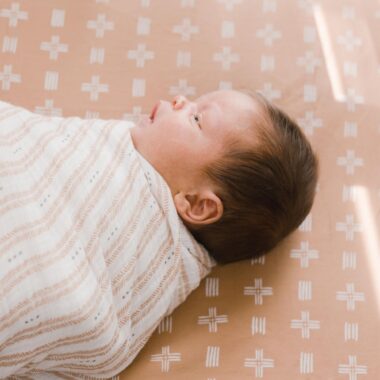
Newborn Sleep Safety
Before diving into the types of bedding, it’s crucial to emphasize the importance of newborn sleep safety.
- Back to Sleep: Always place your baby on their back to sleep, for naps and at night, to reduce the risk of Sudden Infant Death Syndrome (SIDS).
- Firm Sleep Surface: Use a firm mattress covered with a well fitted sheet designed for your baby’s crib.
- No Loose Bedding: Avoid pillows, blankets, and any loose bedding that could pose a suffocation hazard. This also includes bumper pads.
- Temperature Control: Keep the room at a comfortable temperature and dress your baby in appropriate clothing to prevent overheating.
- No Co-Sleeping: While it may be tempting, it is not safe for newborns to sleep with adults or other children. Always place your baby in their own crib or bassinet.
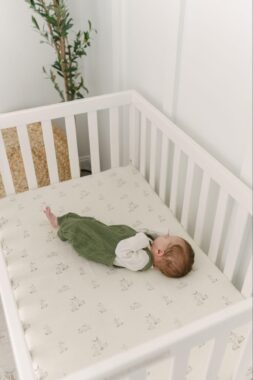
What Bedding is Needed?
When preparing your baby’s crib, keep it simple and stick to the essentials. Here are the bedding items that your newborn needs:
Crib Mattresses
Choosing the right crib mattress is a vital part of ensuring your baby’s safety and comfort. Here’s what to consider when selecting a crib mattress:
Firmness
Firmness is crucial for a safe sleep environment. The mattress should not conform to the shape of your baby’s head or body. Press your hand on the mattress to check its firmness; if it feels soft, it’s not suitable. A firm surface reduces the risk of suffocation and Sudden Infant Death Syndrome (SIDS).
Fit and Size
The mattress should fit snugly in the crib with no more than two fingers’ width between the mattress and crib walls. This prevents your baby from getting trapped in any gaps, ensuring a safer sleep environment.
Breathability
A breathable mattress is essential for newborns who have not yet developed the ability to turn their head or lift it if they are face down. Look for a mattress with ventilation holes or one made of breathable materials such as organic cotton.
Certifications
Look for mattresses that meet safety standards and certifications, such as those from the Juvenile Products Manufacturers Association (JPMA) or the Consumer Product Safety Commission (CPSC). Certifications like Greenguard Gold also ensure the mattress meets strict chemical emissions standards, contributing to a healthier indoor environment.
Mattress Protector
In addition to a safe and comfortable crib mattress, a mattress protector is an essential accessory for your baby’s bedding. A good mattress protector serves multiple purposes:
- Protection Against Spills and Leaks: Babies are prone to accidents, including diaper leaks and spit-ups. A waterproof mattress protector helps keep the mattress clean and dry, extending its lifespan.
- Hygiene: A mattress protector creates a barrier between the mattress and your baby, reducing the risk of allergens, dust mites, and bacteria. This is particularly beneficial if your baby has sensitive skin or allergies.
- Ease of Cleaning: Mattress protectors are typically easier to remove and wash than the mattress itself. Regular cleaning ensures a fresh and hygienic sleeping surface for your little one.
- Comfort: Some mattress protectors come with additional padding, providing an extra layer of softness without compromising the firmness needed for safety.
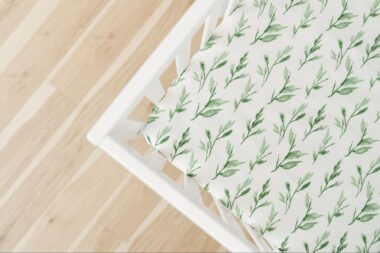
Fitted Crib Sheets
Fitted crib sheets are another crucial component of your newborn’s bedding. These sheets are designed to fit snugly over the mattress, providing a smooth and secure sleeping surface. Here’s what you need to know when selecting fitted crib sheets:
Material
Choose fitted crib sheets made from soft, breathable materials like cotton or bamboo. These fabrics are gentle on your baby’s delicate skin and help regulate temperature, ensuring your baby remains comfortable throughout the night. Organic options are available if you prefer natural, chemical-free materials.
Fit
Ensure that the fitted crib sheets are the correct size for your baby’s mattress. A properly fitted sheet will stay securely in place, reducing the risk of bunching or becoming loose, which can be a suffocation hazard. The elastic should wrap around the entire edge of the mattress for a snug fit.
Quantity
Having multiple fitted crib sheets on hand is essential. Newborns can go through several sheets in a week due to diaper leaks, spit-ups, or other accidents. Keeping a few extras will make it easier to quickly change the bedding without undue stress.
Durability
Look for fitted crib sheets that are durable and can withstand frequent washing. High-quality sheets will retain their softness and shape, providing a consistently comfortable sleeping environment for your baby.
Safety
The safety of your baby is of paramount importance. Avoid any sheets with embellishments like ribbons, buttons, or applique that could come loose and pose a choking hazard. Ensure that the sheets are free from loose threads and are in good condition regularly.
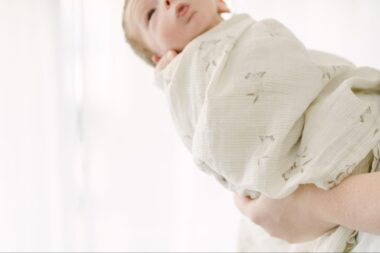
Swaddle Blankets
Swaddle blankets are an excellent addition to your newborn’s bedding, offering comfort and security that can help them sleep better. Swaddling mimics the snug environment of the womb, which can soothe your baby and reduce instances of the startle reflex waking them up.
Material
When selecting swaddle blankets, opt for soft, breathable materials such as cotton, muslin, or bamboo. These fabrics are gentle on your baby’s skin and will help regulate their body temperature, ensuring they remain comfortable.
Size and Fit
Swaddle blankets should be large enough to wrap your baby securely but not too tight. Typically, a 40×40 inch or larger blanket is a good size for getting a snug fit that won’t come loose during sleep. Look for blankets specifically designed for swaddling to get the best results.
Safety
Safety is the most important when using swaddle blankets. Always swaddle snugly but not too tight around the hips. Ensure the swaddle blanket doesn’t come up too high around the face, which could pose a suffocation risk. Always place your baby on their back to sleep when swaddled.
Benefits
Swaddling can provide several benefits, including:
- Improved Sleep: The snug feeling can help your newborn stay asleep longer by preventing them from startling themselves awake.
- Comfort and Security: Mimicking the womb’s environment can calm a fussy baby, creating a sense of security.
- Temperature Regulation: Using breathable materials ensures that the baby remains comfortable without overheating.
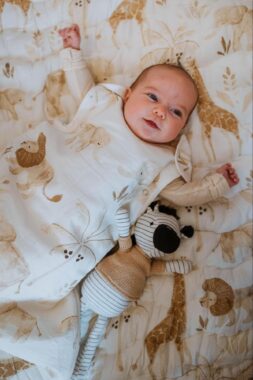
Wearable Blankets
Wearable blankets, often referred to as sleep sacks, are absolutely essential for ensuring your baby sleeps safely and comfortably. Unlike loose blankets that can pose a suffocation hazard, wearable blankets are designed to be worn like a garment, providing warmth without the risks associated with traditional bedding.
Benefits
Wearable blankets offer several benefits that can contribute to a safer and more restful night’s sleep for your baby:
- Consistent Warmth: They ensure your baby stays warm without the need for additional blankets, reducing the risk of suffocation.
- Ease of Use: Many wearable blankets feature easy-to-use zippers or snaps, making nighttime diaper changes more convenient.
- Peace of Mind: Parents can have peace of mind knowing their baby is sleeping in a safe environment that reduces the risks associated with loose bedding.
Material
Choose wearable blankets made from soft, breathable fabrics such as cotton. These materials are gentle on your baby’s delicate skin and assist in regulating their body temperature throughout the night, preventing overheating.
Types of Wearable Blankets
- Lightweight Muslin Sleep Sacks: Ideal for warmer climates or seasons, these are made from breathable muslin and often feature sleeveless designs to keep your baby cool.
- Quilted Sleep Sacks: These provide extra warmth and are best suited for cooler climates or winter months.
Safety
When using a wearable blanket, always lay your baby on their back to sleep. Check that the blanket fits correctly, being neither too tight nor too loose, to prevent any part from covering the baby’s face. Regularly inspect the wearable blanket for signs of wear and tear or loose threads that could pose a hazard.
Creating a safe, comfortable, and nurturing sleep environment for your baby is an essential part of their well-being and development. By choosing the right materials, ensuring proper fit, and prioritizing safety across each item of bedding—whether it’s fitted crib sheets, swaddle blankets, or wearable blankets—you provide both comfort and security for your precious little one. Remember, the key is to combine practicality with warmth and care, ensuring each element contributes to a restful night’s sleep for both baby and parents.